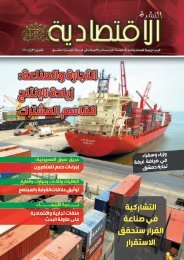SIGAR
2017-01-30qr
2017-01-30qr
You also want an ePaper? Increase the reach of your titles
YUMPU automatically turns print PDFs into web optimized ePapers that Google loves.
COUNTERNARCOTICS<br />
in 2016 at an additional estimated cost of $16.0 million (included in the total<br />
project cost of $61.3 million). Under this extension, CHAMP will focus on<br />
supply chain marketing and export promotion of Afghan fresh and dried<br />
fruits to international markets.<br />
The program will continue to support traders and the trade offices in<br />
New Delhi, India and Dubai, UAE, as well as marketing of other high-value<br />
crops targeted by the RADP programs. Work on the new components of<br />
supply-chain improvement, export-market development and gender integration<br />
began January 2017. 886 USAID has disbursed $46.7 million as of<br />
December 31, 2016. 887<br />
See the October 2016 <strong>SIGAR</strong> Quarterly Report to the United States<br />
Congress for more information.<br />
INTERDICTION OPERATIONS AND RESULTS<br />
The Counternarcotics Police of Afghanistan (CNPA) consists of regular<br />
narcotics police and specialized units in all 34 provinces. The specialized<br />
units include the Sensitive Investigation Unit (SIU), National Interdiction<br />
Unit (NIU), and the Intelligence Investigation Unit (IIU). Nearly half<br />
of the CNPA’s 2,000 personnel are assigned to Kabul. In addition to the<br />
CNPA, law-enforcement elements contributing to interdiction activities<br />
include members of the Afghan National Police, Afghan Border Police,<br />
and Afghan Uniform Police. 888 INL provides funding for the NIU; DEA<br />
funds the SIU. 889<br />
Since 2004, DOD’s counternarcotics (CN) requirements for Afghanistan<br />
have been funded mostly through supplemental and Overseas Contingency<br />
Operations appropriations. These train-and-equip programs aim to support<br />
U.S. regional goals and reduce CN-related terrorism and financing. The<br />
majority of funding is for special-purpose vetted units such as the Special<br />
Mission Wing (SMW) and the CNPA. 890<br />
According to DOD, a poor security environment has impeded counternarcotics<br />
operations in the south and southwest. Nonetheless, the number<br />
of interdiction operations for the first quarter of FY 2017 rose from 21 to<br />
24 due to mentoring from U.S. special forces, access to Resolute Support<br />
mission assets and partnership with wider Afghan military operations. 891<br />
Furthermore, the drawdown of Coalition forces has negatively affected the<br />
CNPA and other Afghan counternarcotics agencies, particularly in Helmand<br />
and Kandahar Provinces, where the Coalition surge and subsequent<br />
withdrawal was focused. 892 Less frequent partnering of Resolute Support<br />
mission and Afghan forces has reduced available transportation, particularly<br />
helicopters, and the use of some counternarcotics forces for general<br />
security in areas where the drug trade and anti-government forces are concentrated<br />
in southern, southwestern, and northern Afghanistan has resulted<br />
in fewer counterdrug missions. 893<br />
“Because they [the Taliban]<br />
receive much of their<br />
funding from the narcotics<br />
trafficking that occurs<br />
out of Helmand. As you<br />
know, Helmand produces<br />
a significant amount of<br />
the opium globally that<br />
turns into heroin and this<br />
provides about 60 percent<br />
of the Taliban funding,<br />
we believe.”<br />
—General John Nicholson,<br />
Commander, Resolute Support and<br />
U.S. Forces Afghanistan<br />
Source: General John Nicholson, Department of Defense<br />
Pentagon press briefing, 12/2/2016.<br />
REPORT TO THE UNITED STATES CONGRESS I JANUARY 30, 2017<br />
199







